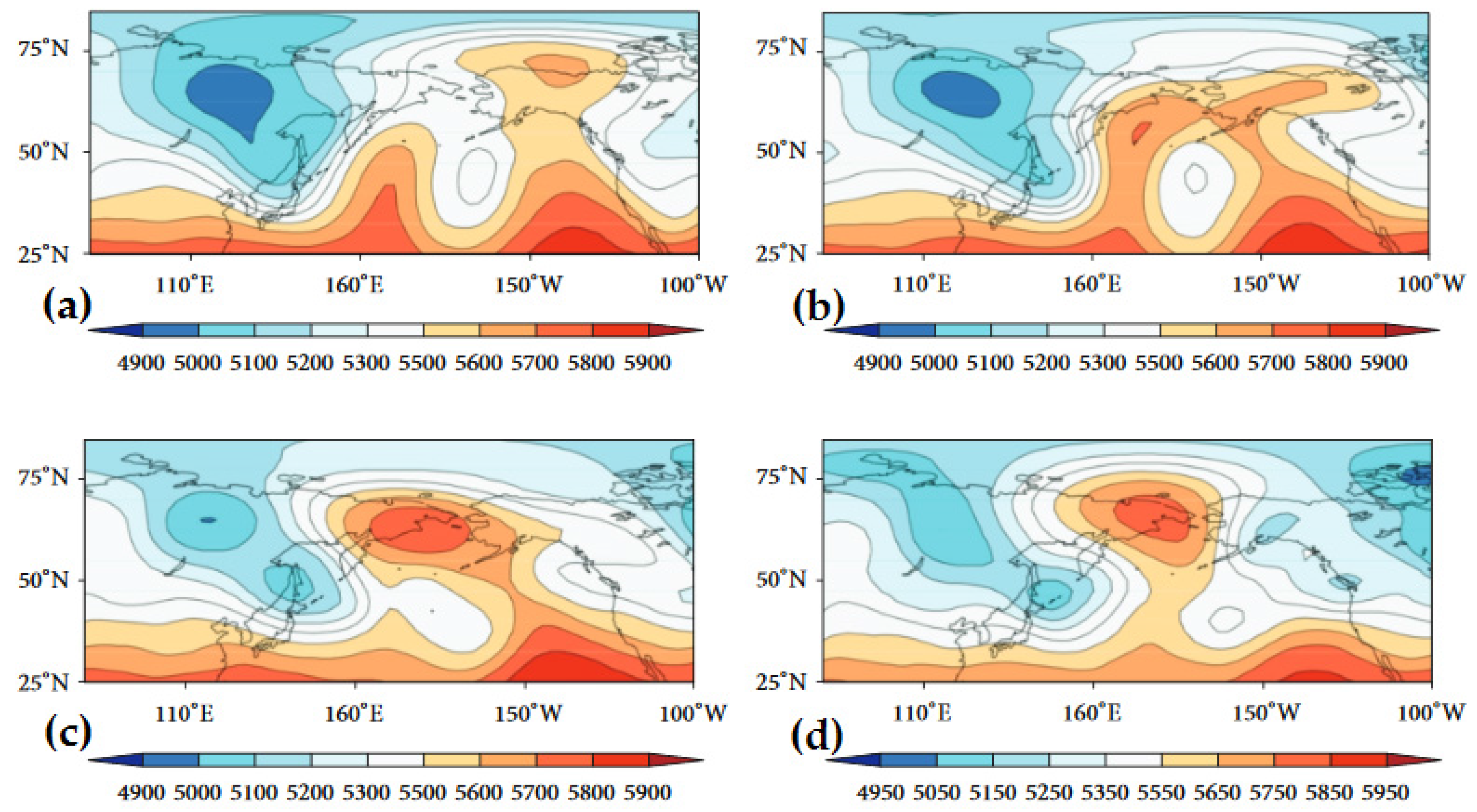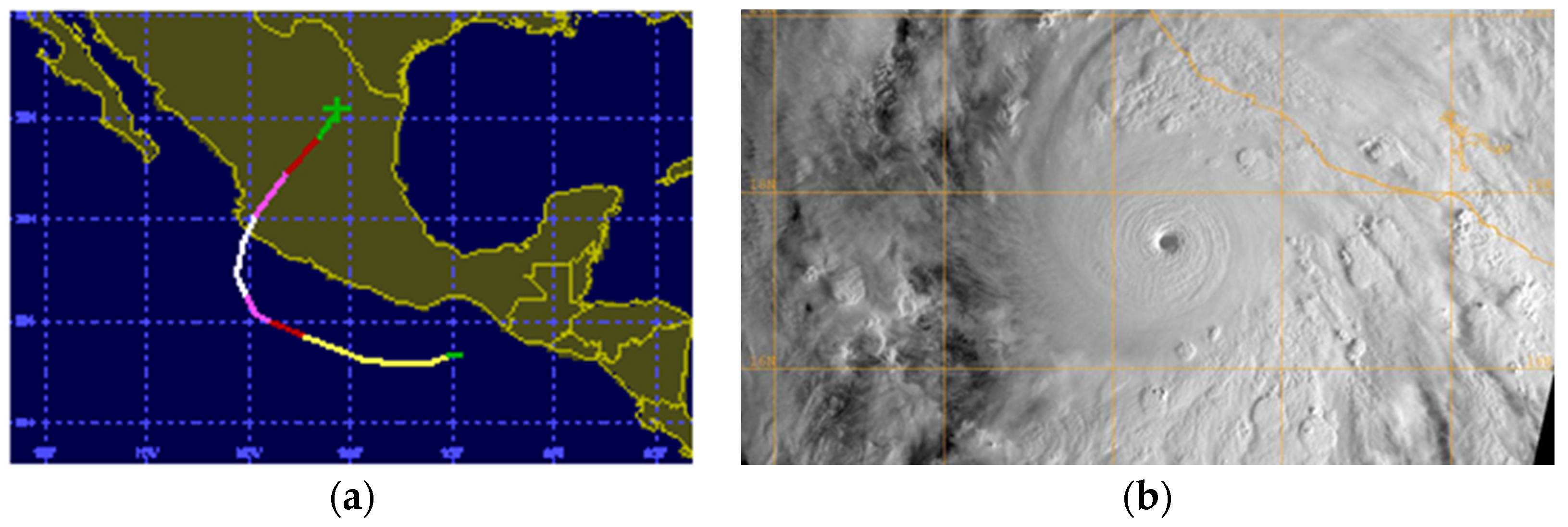Sensitive versus Rough Dependence under Initial Conditions in Atmospheric Flow Regimes
Abstract
:1. Introduction
2. Experiments
2.1. Data
2.2. Methods
3. Results
3.1. Case Study, Atmospheric Blocking
3.2. Case Study, Hurricane Patricia
3.3. Case Study—Midwest Rain Event
4. Discussion and Conclusions
Acknowledgments
Author Contributions
Conflicts of Interest
References
- Haltiner, G.J.; Williams, R.T. Numerical Prediction and Dynamic Meteorology, 2nd ed.; Wiley and Sons, Inc.: Hoboken, NJ, USA, 1980. [Google Scholar]
- Durran, D.R. Numerical Methods for Wave Equations in Geophysical Fluid Dynamics; Springer: Berlin, Germany, 1999. [Google Scholar]
- Lorenz, E.N. Deterministic, non-periodic flow. J. Atmos. Sci. 1965, 20, 130–141. [Google Scholar] [CrossRef]
- Lorenz, E.N. A study of the predictability of a 28-variable model. Tellus 1963, 17, 321–333. [Google Scholar] [CrossRef]
- Toth, Z.; Kalnay, E. Ensemble forecasting at NCEP: The generation of perturbations. Bull. Am. Meteorol. Soc. 1993, 74, 2317–2330. [Google Scholar] [CrossRef]
- Toth, Z.; Kalnay, E. Ensemble forecasting at NCEP and the breeding method. Mon. Weather Rev. 1997, 125, 3297–3319. [Google Scholar] [CrossRef]
- Tracton, M.S.; Kalnay, E. Operational ensemble forecasting at the National Meteorological Center: Practical Aspects. Weather Forecast. 1993, 8, 379–398. [Google Scholar] [CrossRef]
- National Centers for Environmental Prediction Ensemble Products. Available online: http://www.esrl.noaa.gov/psd/map/images/ens/ens.html#nh (accessed on 5 December 2016).
- Holton, J.R.; Hakim, G.J. An Introduction to Dynamic Meteorology; Academic Press, Elsevier: Amsterdam, The Netherlands, 2012. [Google Scholar]
- Lupo, A.R. The role of ageostrophic forcing in a Height Tendency Equation. Mon. Weather Rev. 2002, 130, 115–126. [Google Scholar] [CrossRef]
- Li, Y.C. The distinction of turbulence from chaos—Rough dependence on initial data. Electron. J. Differ. Equ. 2014, 2014, 1–8. [Google Scholar]
- Li, Y.C. Rough Dependence upon Initial Data Exemplified by Explicit Solutions and the Effect of Viscosity. Available online: https://arxiv.org/abs/1506.05498 (accessed on 1 December 2016).
- Lupo, A.R.; Smith, P.J.; Zwack, P. A diagnosis of the development of two extratropical cyclones. Mon. Weather Rev. 1992, 120, 1490–1523. [Google Scholar] [CrossRef]
- Feng, Z.C.; Li, Y.C. Short term unpredictability of high Reynolds number turbulence—Rough dependence on initial data. Unpublished work. 2016. [Google Scholar]
- Kalnay, E.; Kanamitsu, M.; Kistler, R. The NCEP/NCAR 40-year reanalysis project. Bull. Am. Meteorol. Soc. 1996, 77, 437–471. [Google Scholar] [CrossRef]
- Kistler, R.; Kalnay, E.; Collins, W. The NCEP-NCAR 50-year reanalysis: Monthly means CD-ROM and documentation. Bull. Am. Meteorol. Soc. 2001, 82, 247–267. [Google Scholar] [CrossRef]
- UNISYS Weather Website. Available online: http://weather.unisys.com (accessed on 5 December 2016).
- Smith, T.M.; Elmore, K.L. The use of radial velocity derivatives to diagnose rotation and divergence. In Proceedings of the 11th Conference on Aviation, Range, and Aerospace, Hyannis, MA, USA, 4–8 October 2004.
- Lakshmanan, V.; Smith, T.; Hondl, K.; Stumpf, G.; Witt, A. A Real-Time, Three-Dimensional, Rapidly Updating, Heterogeneous Radar Merger Technique for Reflectivity, Velocity, and Derived Products. Weather Forecast. 2006, 21, 802–823. [Google Scholar] [CrossRef]
- Lack, S.A.; Fox, N.I. Development of an automated approach for identifying convective storm type using reflectivity-derived and near-storm environment data. Atmos. Res. 2012, 116, 67–81. [Google Scholar] [CrossRef]
- Dymnikov, V.P.; Kazantsev, Y.V.; Kharin, V.V. Information entropy and local Lyapunov exponents of barotropic atmospheric circulation. Izv. Atmos. Ocean. Phys. 1992, 28, 425–432. [Google Scholar]
- Weiss, J. The dynamics of enstrophy transfer in two-dimensional hydrodynamics. Phys. D Nonlinear Phenom. 1991, 48, 273–294. [Google Scholar] [CrossRef]
- Jensen, A.D.; Lupo, A.R. Using enstrophy based diagnostics in an ensemble for two blocking events. Adv. Meteorol. 2013, 2013, 693859. [Google Scholar] [CrossRef]
- Ott, E. Chaos in Dynamical Systems; Cambridge University Press: New York, NY, USA, 1993. [Google Scholar]
- University of Missouri Blocking Archive. Available online: http://weather.missouri.edu/gcc (accessed on 5 December 2016).
- Quiroz, R.S. The climate of the 1983–84 winter: A season of strong blocking and severe cold in North America. Mon. Weather Rev. 1984, 112, 1894–1912. [Google Scholar] [CrossRef]
- Jensen, A.D. A dynamic analysis of a record breaking winter season blocking event. Adv. Meteorol. 2015, 2015, 634896. [Google Scholar] [CrossRef]
- Haines, K.; Holland, A.J. Vacillation cycles and blocking in a channel. Q. J. R. Meteorol. Soc. 1998, 124, 873–897. [Google Scholar] [CrossRef]
- Lupo, A.R.; Mokhov, I.I.; Dostoglou, S.; Kunz, A.R.; Burkhardt, J.P. Assessment of the impact of the planetary scale on the decay of blocking and the use of phase diagrams and enstrophy as a diagnostic. Izv. Atmos. Ocean. Phys. 2007, 43, 45–51. [Google Scholar] [CrossRef]
- Wiedenmann, J.M.; Lupo, A.R.; Mokhov, I.I.; Tikhonova, E.A. The climatology of blocking anticyclones for the Northern and Southern Hemispheres: Block intensity as a diagnostic. J. Clim. 2002, 15, 3459–3473. [Google Scholar] [CrossRef]
- Stanford University—Standard Atmosphere Computations. Available online: http://aero.stanford.edu/stdatm.html (accessed on 5 December 2016).
- UNISYS Weather— Hurricane Archive. Available online: http://weather.unisys.com/hurricane/index.php (accessed on 5 December 2016).
- Sanders, F.; Gyakum, J.R. Synoptic-dynamic climatology of the “bomb”. Mon. Weather Rev. 1980, 108, 1577–1589. [Google Scholar] [CrossRef]
- Houze, R.A. Clouds in tropical cycles. Mon. Weather Rev. 2010, 138, 293–344. [Google Scholar] [CrossRef]
- Schubert, W.H.; Montgomery, M.T.; Taft, R.K.; Guinn, T.A.; Fulton, S.R.; Kossin, J.P.; Edwards, J.P. Polygonal eyewalls, asymmetric eye contraction, and potential vorticity mixing in hurricanes. J. Atmos. Sci. 1999, 56, 1197–1223. [Google Scholar] [CrossRef]
- National Oceanic and Atmospheric Administration—Daily Weather Map Series. Available online: http://www.wpc.ncep.noaa.gov/dailywxmap/index.html (accessed on 5 December 2016).
- Matsueda, M. Predictability of Euro-Russian blocking in summer of 2010. Geophys. Res. Lett. 2011, 38, L06801. [Google Scholar] [CrossRef]






| Case Study | Mean Vorticity (s−1) | IRE (m2·s−2) | RHS |
|---|---|---|---|
| A. Blocking | 1.6 × 10−4 | 6.5 × 108 | 1.4 × 108 |
| B. Hurricane | 9.8 × 10−5 | 1.4 × 108 | 1.4 × 109 |
| C. Small-scale rain | 2.4 × 10−2 | 3.6 × 107 | 7.0 × 108 |
© 2016 by the authors; licensee MDPI, Basel, Switzerland. This article is an open access article distributed under the terms and conditions of the Creative Commons Attribution (CC-BY) license (http://creativecommons.org/licenses/by/4.0/).
Share and Cite
Lupo, A.R.; Li, Y.C.; Feng, Z.C.; Fox, N.I.; Rabinowitz, J.L.; Simpson, M.J. Sensitive versus Rough Dependence under Initial Conditions in Atmospheric Flow Regimes. Atmosphere 2016, 7, 157. https://doi.org/10.3390/atmos7120157
Lupo AR, Li YC, Feng ZC, Fox NI, Rabinowitz JL, Simpson MJ. Sensitive versus Rough Dependence under Initial Conditions in Atmospheric Flow Regimes. Atmosphere. 2016; 7(12):157. https://doi.org/10.3390/atmos7120157
Chicago/Turabian StyleLupo, Anthony R., Y. Charles Li, Z. C. Feng, Neil I. Fox, Jordan L. Rabinowitz, and Micheal J. Simpson. 2016. "Sensitive versus Rough Dependence under Initial Conditions in Atmospheric Flow Regimes" Atmosphere 7, no. 12: 157. https://doi.org/10.3390/atmos7120157
APA StyleLupo, A. R., Li, Y. C., Feng, Z. C., Fox, N. I., Rabinowitz, J. L., & Simpson, M. J. (2016). Sensitive versus Rough Dependence under Initial Conditions in Atmospheric Flow Regimes. Atmosphere, 7(12), 157. https://doi.org/10.3390/atmos7120157







